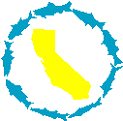CSPA |
| Your 501(c)(3) tax deductible cash donations are desperately needed if the fight for our fisheries is to continue. Read how you can donate! |
 Enter your Email address to sign up Enter your Email address to sign up for our Weekly Newsletter For Email Marketing you can trust |
More News
![]()
 Irrigation Districts Confess: it's the pumps and inadequate flows that are killing Central Valley salmon: Modesto and Turlock Irrigation Districts cite Delta pumps' effects on salmon and acknowledge that 98.5% of San Joaquin flow never reaches Bay
Irrigation Districts Confess: it's the pumps and inadequate flows that are killing Central Valley salmon: Modesto and Turlock Irrigation Districts cite Delta pumps' effects on salmon and acknowledge that 98.5% of San Joaquin flow never reaches Bay
By Chris Shutes & Bill Jennings
August 6, 2009 -- Two large agricultural irrigation districts in the San Joaquin Valley and the City of San Francisco have finally admitted what CSPA has long known: almost no water and few fish from the San Joaquin River reach San Francisco Bay and the giant state and federal project pumps in the South Delta are responsible.
In filings with the Federal Energy Regulatory Commission, the Modesto and Turlock Irrigation Districts have cited the operation of Delta pumps as “important determinants in the survival of juvenile salmon in the Delta and subsequent adult returns to the Tuolumne River and other San Joaquin River tributaries.” Specifically, the Districts 4 August 2009 submission targets state and federal export rates, and hydraulic barriers designed to prevent entrainment into the Delta pumps.
The filing by the Districts was made for a proceeding ordered by the Federal Energy Regulatory Commission regarding salmon and steelhead fisheries and flows in the lower Tuolumne River.
The Districts also posit several other “uncontested facts” that are relevant to fisheries on the Tuolumne. The Districts note that between 1996 and 2007 export rates from the state and federal Delta export facilities doubled. They state that the winter and spring export levels during this time period exceeded San Joaquin basin outflow at almost all times, except during floods and temporary export reductions during the Vernalis Adaptive Management Program “experiments.” Finally, the Districts state: “On an annual basis, 98.5% of the San Joaquin River outflow never reaches the San Francisco Bay.”
In a parallel filing in the same proceeding, the City and County of San Francisco cites a work by the California Department of Fish and Game that suggests that “there is no obvious relationship (i.e., neither increasing nor decreasing) between smolt abundance and Vernalis flows for flow values (less than) 10,000 cfs (Marston 2005 Figure 32).” The USGS gauge at Vernalis is on the San Joaquin River downstream of the Stanislaus River, the northernmost major tributary to the lower San Joaquin River.
The Merced Irrigation District also acknowledged that San Joaquin River spring flows less than 10,000 cubic feet per second (cfs) will not facilitate salmon migration. In a 16 July 2009 comment letter on an Environmental Impact Report evaluating interim San Joaquin River restoration flows, the District stated: “at flows below 10,000 cfs there is very little correlation between flows at Vernalis and escapement.”
Assuming roughly equal outflows from the Merced, Tuolumne and Stanislaus, spring flows of 10,000 cfs at Vernalis appear to us to be in line with the spring flows greater than 3000 cfs recommended for the Stanislaus River by the National Marine Fisheries Service in the June, 2009 OCAP Biological Opinion for Salmon, Steelhead and Green Sturgeon.
CSPA is pleased to see the irrigation districts and San Francisco calling attention to such important information. It is increasingly clear that curtailment of pumping during the spring period, coupled with flows of at least 10,000 cfs in the spring, are necessary to begin restoration of the once prodigious runs of salmon and steelhead in the San Joaquin River Basin.
The State Water Resources Control Board is presently scheduled to release a draft Environmental Impact Report regarding increased San Joaquin River flows sometime between the fourth quarter of 2009 and the second quarter of 2010. Hearings on potential changes to water rights is scheduled for the second quarter of 2011 with a hearing on a proposed order modifying water rights envisioned by the first quarter of 2012.
Given the precarious state of San Joaquin River salmonid fisheries, CSPA believes the proposed schedule is seriously inadequate and the State Board needs to move quickly and hold expedited hearings to consider interim emergency measures to prevent these fisheries from extinction.